- 1. Key Takeaways
- 2. The Inca Trail to Machu Picchu - What Is It?
- 2.1. How Long Is the Inca Trail?
- 2.2. How Difficult is the Inca Trail?
- 2.3. Why Is the Inca Trail So Popular?
- 3. What You Need to Know Before Booking the Inca Trail Hike
- 3.1. Best Time to Do the Inca Trail Hike
- 3.2. Inca Trail Permits
- 3.3. Contacting a Tour Company
- 3.4. Inca Trail Restrictions
- 3.5. How to Get There?
- 4. What and How to Prepare for the Inca Trail Hike
- 4.1. Mental Preparation for the Inca Trail Trek
- 4.2. Physical Preparation for Hiking the Inca Trail Trek
- 4.3. Acclimate to Avoid Altitude Sickness
- 4.4. Pack Like a Pro
- 5. The Inca Trail Itinerary
- 5.1. Inca Trail Map
- 5.2. Types of Inca Trail Hikes
- 5.3. Getting to Machu Picchu
- 6. Inca Trail Facilities
- 7. Inca Trail Safety
- 8. KÜHL's 5 Tips for Hiking the Inca Trail
- 9. Final Thoughts
- 10. FAQs
- 10.1. Can a beginner do the Inca Trail?
- 10.2. What is the scariest part of the Inca Trail?
- 10.3. What is the failure rate of the Inca Trail?
- 10.4. Who suffers most from altitude sickness?
- 10.5. Is the Inca Trail crowded?
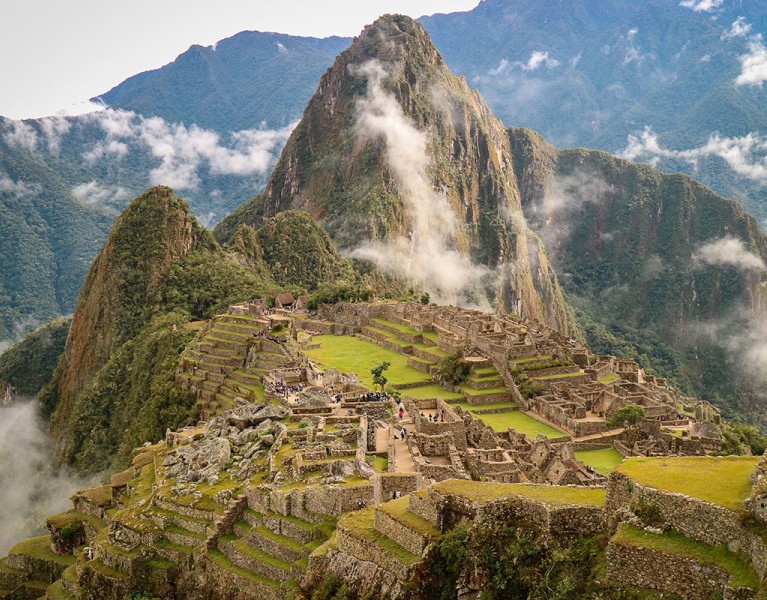
KÜHL’s Expert Guide To Making the Most of The Inca Trail
Table of Contents [Show]
You know the Inca Trail to Machu Picchu in Peru is popular when there is a cap on the number of people who can trek it daily. Still, the permits for this 500-year-old Incan path sell out up to eight months in advance. Yes- it's that famous!
This challenging multi-day hike takes you up mountain passes and through cloud forest valleys before rewarding you with the postcard view of the legendary Machu Picchu.
A must-try for all adventurous hikers, culture lovers, and history buffs, the Incan Trail is a once-in-a-life experience, but be sure to prepare and plan ahead of time. If hiking the Inca Trail is next on your bucket list, we've curated this expert guide with everything from what to wear to the permits needed and how to survive the 4-day trip!
Key Takeaways
- The Inca Trail in Peru is of moderate difficulty. While anybody can complete it, being reasonably fit makes the hike easier.
- There are two major ways of hiking the Inca Trail: a 4-day, 3-night trek and a 5-day, 4-night trek. There's also a 2-day Inca Trail hike option if you are strapped for time, or the multi-day versions are sold out.
- The distance covered and the high attitude involved are the two major problems for most people hiking the Inca Trail in Peru.
- The Classic 4-day Inca Trail stands out from other hiking trails because it was a Royal Sacred Highway at the peak of the Incan Empire. Also, this route is lined with magnificent ruins that are unique to it.
- You must get a permit through a licensed tour operator to hike the Inca Trail. DIY or self-guided Inca Trail Peru hikes are not an option.
The Inca Trail to Machu Picchu - What Is It?
The Inca Trail or Camino Inka is a multi-day trek in Cusco, southern Peru. It whisks you from a place called Kilometer 82 through the Sacred Valley past ancient ruins, enchanting cloud forests, jaw-dropping mountainscapes, and Andean peaks, eventually reaching Machu Picchu via Inti Punku (or the Sun Gate).
How Long Is the Inca Trail?
The Inca Trail is 26 miles (43 km) long. Most Inca Trail tours offer two options for doing the hike: a 4-day, 3-night trek and a 5-day, 4-night option. There's a 2-day Inca Trail hike for those who are short on time or don't want to commit to four days of hiking. This hike lets you enjoy the magic of the classic Inca Trail for a day before getting to the ancient city. More about this later.
How Difficult is the Inca Trail?
The Inca Trail Machu Picchu hike is moderately difficult, meaning most people, including beginner hikers, can do it. But it's not just another stroll around the block.
Day two is usually the most difficult during the hike because it's a relentless uphill and downhill trek to the highest peak of the Inca trail (Dead Woman's Pass, 4200 meters).
Why Is the Inca Trail So Popular?
There are other trails that will get you to the Lost City of the Incas (Machu Picchu). But the Classic 4-day Inca Trail has an aura of uniqueness for several reasons.
First, its purpose. While other roads in the Incan Empire were used for trade, communication, and defense, experts think the Inca Trail was solely used as a pilgrimage route to Machu Picchu.
Second, a popular theory suggests that the Inca Trail was designated for Incan elites, including the emperor and his court. That's why it's often referred to as the Royal Sacred Highway.
Another reason the Inca Trail is held in such high esteem is the set of ancient Inca ruins that can only be accessed via this route: Llactapata, meaning "High City"; Sayacmarca or "The Inaccessible Town"; Phuyupatamarca meaning "Place Above the Clouds"; and Wiñay Wayna (Quechua for "always young").
Above all else, the Inca Trail takes you to Machu Picchu through the Sun Gate- a spectacular holiday city of the Incan Empire and one of the new seven wonders of the world.
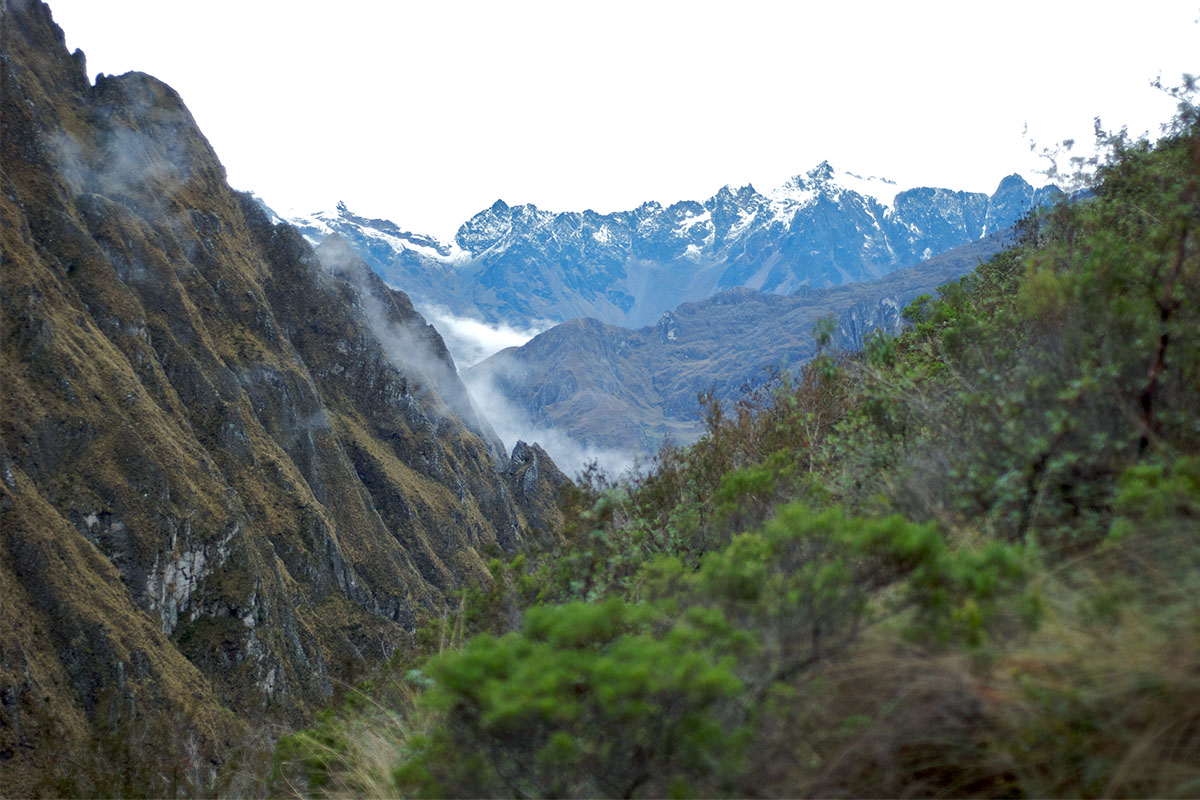
What You Need to Know Before Booking the Inca Trail Hike
Best Time to Do the Inca Trail Hike
Peru has two main seasons: the wet season, which runs from November to March, and the dry season from June to October. The best time to do the Inca Trail hike is June and July because the days are sunny, and the chance of rain is low. But these are the peak months in Peru, so expect large crowds and the permits to sell out faster.
That said, the best time for hiking the Inca Trail without crowds is between late March and May and from September to October.
Late March to May is a good time because it’s just after the rainy season, meaning the weather is great and the landscapes are still green. Plus, the crowds that characterize June and July have not started streaming in yet.
The chance of rain is high between September and October. But these months still offer great trekking conditions without the big crowds of the high season.
The Inca Trail remains closed throughout February each year for renovations. Another reason for the temporary closure is the harsh weather conditions due to the constant rains in February. Only the Inca Trail closes temporarily. Machu Picchu itself remains open throughout the year.
Inca Trail Permits
Since 2001, the Peruvian Ministry of Culture has made it mandatory for everyone to get a permit before hiking the Inca Trail.
Inca Trail permits are capped at 500 people per day. Of these, 300 permits go to guides, porters, cooks, and other support staff. That’s to say, there are only 200 permits that visitors vie for every day.
You cannot purchase Inca Trail permits yourself. To get one, you must sign up for a guided hike with a licensed Inca Trail tour operator. This also means you can’t hike the Inca Trail without a guide.
The cost of Inca Trail permits is almost always baked into the overall price of the trekking tour package. But it’s crucial to verify from the tour company.
Once sold, the Inca Trail tour permit is linked to a specific passport holder for a particular date. The tour company can’t change these details or transfer the permit to another person should anything happen.
Contacting a Tour Company
There are two types of Inca Trail tour companies in Cusco:
- New tour companies that are created annually, particularly for the high season. Some of these act as middlemen. They will sell you the package but contact another company to fulfill the service.
- Well-established agencies that have been in the game for years. These are given 7-10 year permits and organize Inca Trail treks yearly. These companies provide all the services themselves and have a solid team of guides, cooks, porters, and drivers. In other words, your Inca Trail hike is guaranteed.
These are the top-rated Inca Trail tour companies in Cusco currently: Sam Travel Peru, Orange Nation Peru, and Apple Travel Peru.
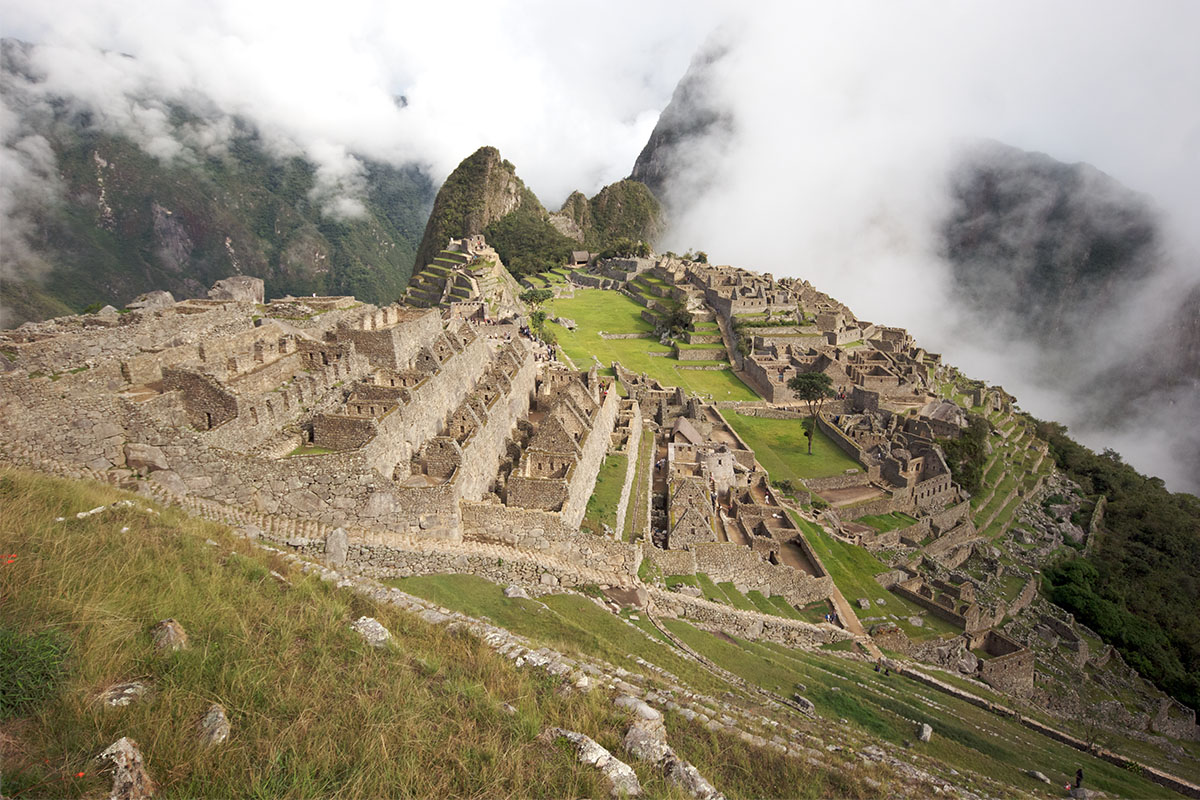
Inca Trail Restrictions
In 2001, the Peru National Institute of Natural Resources developed new regulations to protect the trail, ruins, flora, and fauna. On top of the 500-people-per-day limit, here are other Inca Trail restrictions and prohibitions to bear in mind:
Prohibited Behaviors
- Camping outside of the designated campsites
- Disturbing the flora and fauna species
- Making bonfires anywhere inside the Machu Picchu National Park system
- Taking illegal routes
- Causing disorders
- Smoking
- Flying drones
- Feeding animals
Prohibited Items
- Tripods, selfie sticks, and walking sticks with a metallic or sharp end
- Umbrellas (ponchos and raincoats are allowed)
- Shoes with hard soles and high heels (only soft sole shoes are allowed)
- Baby cars (prams and buggies)
- Non-reusable plastic carry bags
- Backpacks bigger than 40*35*20 cm
- Alcoholic beverages
Who Can Go?
Anybody can do the Inca Trail trek, including children and seniors, so long as they are in good health and feel capable. The Peruvian government has yet to put age limits for Incan Trail hikers. But the tour operators are allowed to do so. Enquire from the tour company whether there are age limitations if you hope to hike the trail as a group or family.
Should I Book In Advance?
Yes, trekking the Machu Picchu Inca Trail requires an advanced reservation with a tour company. Inca Trail permits for the upcoming year are released from October 1st.
For instance, 2024 Inca Trail permits will be released to tour companies throughout October 2023. Tour operators that purchase these permits already have advanced bookings. So, it’s not shocking when permits for the most popular months (April through August) sell out within days- sometimes hours.
It’s recommended to get your Inca Trail tour reservation 6 to 8 months in advance. If you get to Cusco hoping to fill a slot left empty by a no-show, you will be disappointed because the permits are not transferable.
How to Get There?
The Inca Trail starts near Cusco (also spelled Cuzco), a city in southeastern Peru. So, your first order of business will be to get there.
Your tour operator will pick you up from your Cusco hotel between 4:30 AM and 6:30 AM and drive you to Piscacucho, or Kilometer 82. Kilometer 82 is where the old Inca Trail trek to Machu Picchu starts. It gets its nickname from its location, 82 kilometers along the railway from Cusco to Machu Picchu.
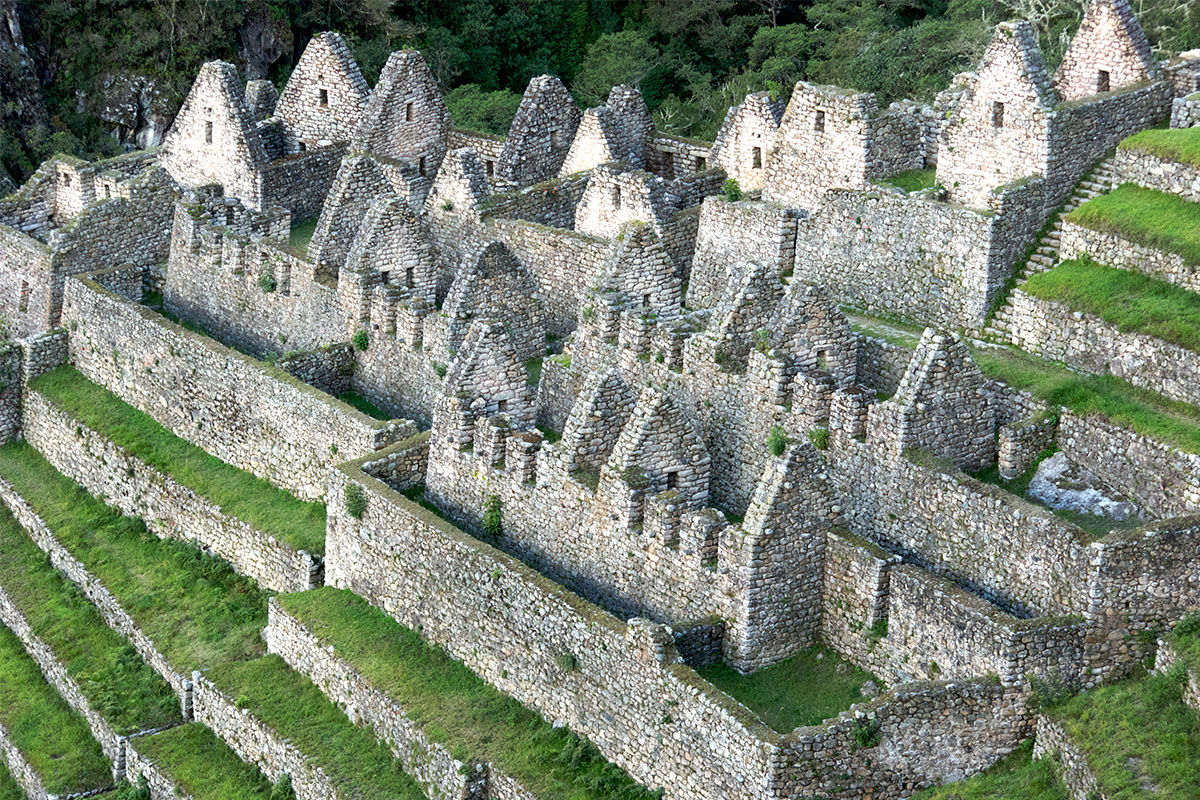
What and How to Prepare for the Inca Trail Hike
If you are hiking the Inca Trail to Machu Picchu, you must be physically and mentally prepared. Thorough planning on what to include in your camping checklist is vital to avoid surprises along the trail.
Mental Preparation for the Inca Trail Trek
Physical training is a key element for hiking the Inca Trail. But mental toughness enables you to persist in the tough 4-day hike. The Inca Trail has areas that will make you question why you signed up for the tour in the first place. This is where your grit or willpower will come in.
So, how do you prepare mentally for the Inca Trail hike? Start by visualizing yourself hiking the trail. YouTube videos by people who have trekked the trail are a good place to better understand what it will be like. Consider all the possible challenges you may face, from exhaustion to dehydration, and visualize how to overcome them.
Replicating the experience at home is another great way of boosting your confidence in completing the Inca Trail. You’ll be waking up at 4 AM during the hike. We suggest waking up around the same time when hiking home so your body gets ready for what’s to come.
Physical Preparation for Hiking the Inca Trail Trek
Hiking the Inca Trail is, without a doubt, an arduous journey. While anybody can do it, it’s relatively easier (and more enjoyable) if you are physically prepared. Walking, swimming, hiking, and cycling are commonly suggested ways of preparing to hike the Inca Trail.
Whatever you do, ensure you include cardio or aerobic exercises in your training regimen. Cardiovascular exercises will give your heart muscles and lungs the type of workout necessary to prevent shortness of breath when hiking this Incan trail.
We recommend starting your training regimen 3-6 months in advance if you are out of shape and at least two months if you consider yourself physically fit.
Acclimate to Avoid Altitude Sickness
The major deterrents when hiking the Peru Inca trail are the distance covered and the attitude. You will cover 43 kilometers at mostly 3000 to 4000 meters above sea level elevations.
If you are coming from sea level, the chances of suffering from altitude sickness will be high. This ailment is caused by the drastic change in air pressure and oxygen levels. It’s characterized by shortness of breath, nausea, dizziness, and headache.
Solution? Give yourself enough time to acclimate. Unless you live in high altitude areas, ensure you get to Cusco 2-3 days before hiking to allow your body to adjust. Cusco sits 3,399 meters above level and offers the perfect place to get ready for the Inca Trail elevation. And there are plenty of fun things to do in this former capital of the Inca empire as your body adjusts.
Pack Like a Pro
You will divide your luggage into two when hiking the Inca Trail:
- A large duffel bag that your tour operator’s porters will help you carry. Your tour organizer will supply this bag during the first briefing in Cusco. You’ll also be advised on what to pack in it, particularly your overnight essentials: sleeping bag, toiletries, clothing, etc. This bag should not exceed 6 kilos because porters also have to carry the entire team’s camping food, kitchen equipment, tables, and benches.
- A small daypack for all other essentials you’ll need during the trek, including your camera, sunscreen, and water bottle. You’ll be responsible for carrying this bag to Machu Picchu, so pack just what you need.
You will leave all other non-hiking items in your main suitcase or backpack in your Cusco hotel. Most Cusco hotels provide guests with free luggage storage if they return after the trek. Verify with your hotel before booking in.
What to Include in Your Inca Trail Packing List
You probably won’t need everything in your typical camping checklist when hiking the Inca Trail. But you must put a lot of time into packing your two bags to ensure you include all the essentials.
Clothing
- Three short-sleeve shirts/t-shirts and one long-sleeve. We recommend 95% to 100% polyester shirts because they are more breathable and wick away moisture instead of holding onto it.
- 2-3 pairs of zip-off pants. Go for 100% nylon pants because they are strong, lightweight, and dry fast. The zip-off design ensures they can go either way, depending on the way, while saving space.
- Four pairs of underwear. Avoid cotton underwear, as they can cause chafing and irritation. For ladies, bring two sports bras.
- Thermals for the high passes and cold evenings
- A fleece pullover and beanie for colder nights at camp
- Lightweight poncho/rain jacket
- Comfortable and waterproof hiking boots. Make sure they are broken in before the trek.
- Silk sock liners. These allow you to bring fewer pairs of hiking socks because you can wear a pair more than one day.
- Mountaineering socks. These will help keep you comfortable by regulating temperature and lowering the risk of friction.
- A warm hat and gloves
- Sunglasses and sunscreen
Extra Accessories
- Your original passport - you won’t be allowed to enter the trail or Machu Picchu without it
- Sleeping bag (can be hired in Cusco)
- Two water bottles or a water bladder
- Wet wipes
- Insect repellant
- Sunscreen and lip balm
- Walking poles
- Camera with spare batteries (instead of a solar panel)
- Hiking food, particularly snacks like dried fruits
- Toilet paper - you won’t find any in most of the toilets along the trails
- A first aid checklist with bandaids, altitude sickness medication, panadol, rehydration sachets, and any other personal medication.
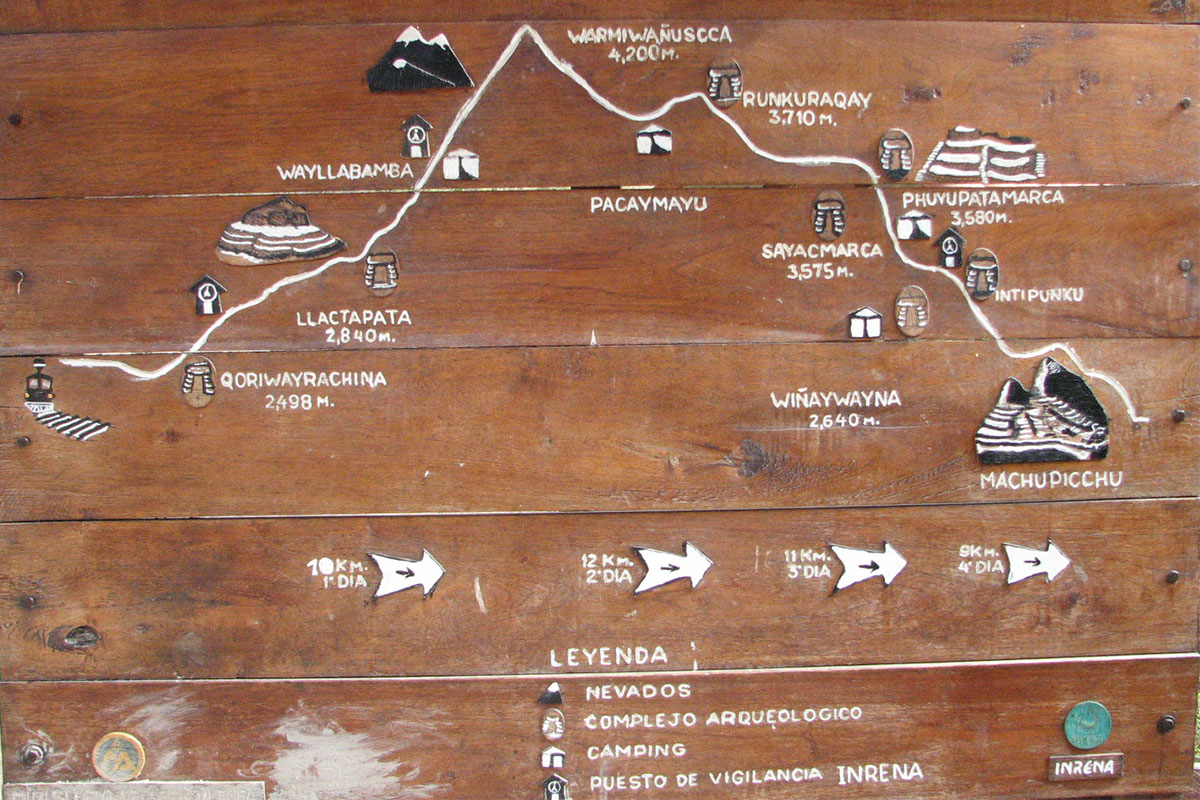
The Inca Trail Itinerary
Inca Trail Map
Here is an overview of the 4-day Inca Trail map and what happens each day:
Day One
- Start: KM 82
- End: Wayllabamba Campsite
- Gradient: Moderate
- Distance covered: 12 kilometers
- Trekking time: 6-7 hours
- Elevation gain: 430 m/1,410 ft.
Your tour operator picks you up from your Cusco hotel and drives you to Kilometer 82. The journey takes roughly 2-½ hours. The trekking team heads to the first checkpoint and then starts a relatively gentle hike along the Urubamba River before gradually climbing uphill.
Day Two
- Start: Wayllabamba Campsite
- End: Pacaymayu
- Gradient: Challenging
- Distance covered: approx 11 kilometers
- Trekking time: 7 hours on average
- Elevation gain: 1,180 m/3,871 ft.
You’ll wake up around 5:30 AM to a hearty breakfast, perfect for the tough hike ahead. Day two is generally considered the most challenging during the trek because this is when you hike to the highest point of the Inca Trail- Warmihuañusca or Dead Woman pass.
Day Three
- Start: Pacaymayo
- End: Wiñay Wayna
- Gradient: Moderate
- Distance covered: approx 16 kilometers
- Trekking time: 8 hours
- Elevation gain: 453 m/1,486 ft.
The goal of the day is to reach Wiñay Wayna campsite at around 5 PM. After breaking camp, you’ll hike uphill for an hour to Runkurakay and another hour to the second-highest point of the Inca Trail- the Runkurakay Pass, sitting some 4000 meters above sea level. On this day, you’ll be able to visit the ruins of Sayacmarca, Phuyupatamarca, and the strikingly beautiful agricultural Inca site of Intipata.
Day Four
- Start: Wiñay Wayna
- End: Machu Picchu
- Gradient: Moderate
- Distance covered: 6 kilometers
- Trekking Time: 2 hours
- Elevation gain: 90 m/295 ft
This marks the last day on the trail. You’ll wake up early, around 4:30 AM, because the goal is to reach the Sun Gate (or Intipunku) before the day breaks. You’ll get to the Sun Gate at around 7 AM, just in time to witness the sun pouring its first rays over the ancient ruins of Machu Picchu. As you can imagine, it’s an unforgettable sight!
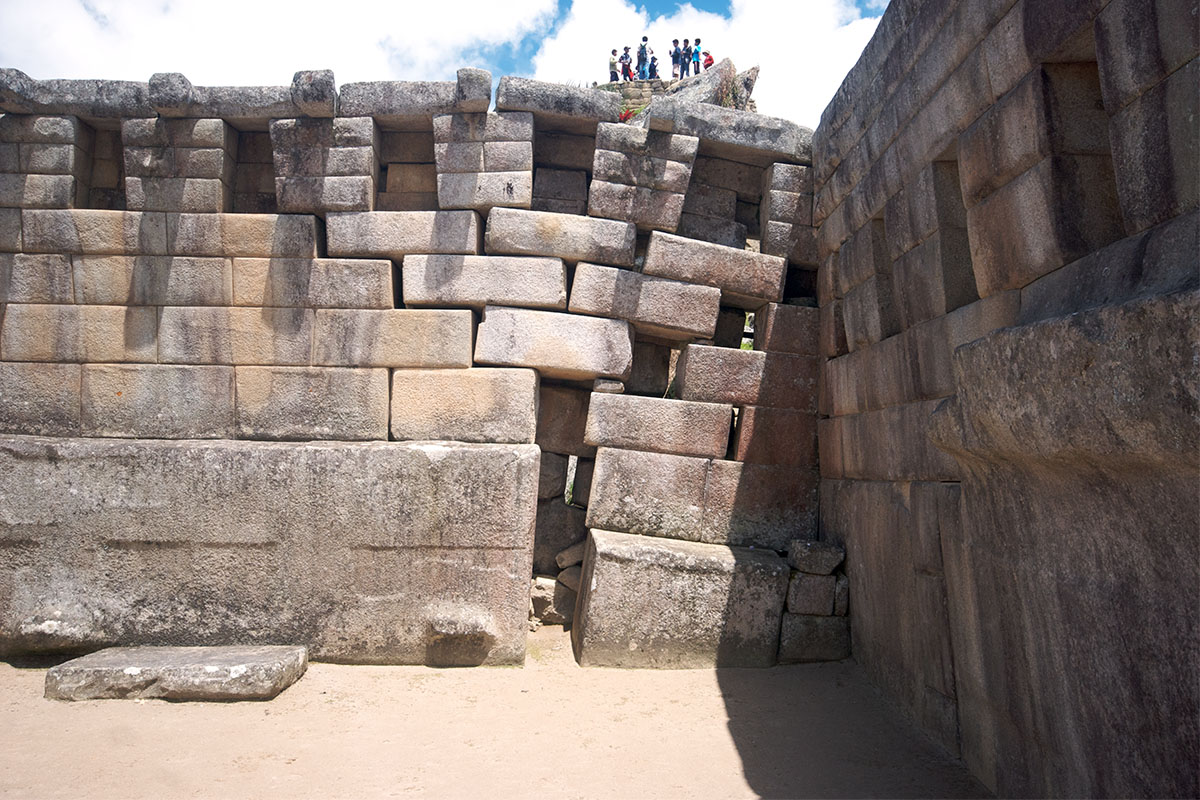
Types of Inca Trail Hikes
There are three major ways of experiencing the magic of the Inca Trail in Peru: a 4-day, 3-night hike, a 5-day, 4-night trek, and a 2-day hike. Each of these options has its advantages and disadvantages.
The Iconic 4-day, 3-night Inca Trail Trek
The traditional 4-day trek is the most popular option. It’s shorter by a day and less expensive, making it great if you have time and budget constraints. But you have to contend with a larger group of trekkers, which means more crowded campsites.
The 5-day, 4-night Inca Trail Trek
With the 5-day hike tour, you wake up between 7 and 9 AM (not 4 AM), meaning more sleep daily. Plus, you hike in the daylight for optimal views of the ruins and natural sceneries along the way. You also get to visit Machu Picchu twice (not once) and sleep at a real hotel with hot showers in Aguas Calientes town on the fourth night. On the flip side, this option is more expensive because of the additional day and overnight stay in a hotel.
The 2-day Inca Trail Hike
Families and travelers looking for a taste of Machu Picchu without trekking for 3 or 5 days can also choose the 2-day hike. This hike starts at KM 104 and is about 7.5 miles, or 12 km, long. You hike most of the route on day one and explore Machu Picchu on the second day.
Getting to Machu Picchu
Congratulations! You've just survived hiking the Royal Road as the Incan elites and pilgrims used to over 500 years ago. Upon reaching Machu Picchu, you'll get a two-hour guided tour of the citadel by your tour organizer, after which you'll be left to explore further at your tempo.
The tour guides will take you to the most spectacular corners of Machu Picchu, including the Sacred Plaza, the House of the Guardian, Intihuatana, and the Temple of the Sun. But there are many other must-see locations within or near the ruins, including the Inca Bridge. And if you still have some energy left, hiking Huayna Picchu- the mountain that rises over Machu Picchu- may be an excellent way to expend it.
A heads up from us: be ready to share the Inca sacred city of Machu Picchu with crowds of non-hiking visitors who will probably have arrived before you. Also, remember to use the restrooms before entering the ruins. There are no toilets inside Machu Picchu, and you won't be allowed to re-enter.
Inca Trail Facilities
Accommodation when hiking the Inca Trail is in tents. Dispersed camping when hiking the Inca Trail is not permitted. Tents can only be set up in Peruvian government-controlled campgrounds. Most Inca Trail tour operators will provide the tent and even set and pack them up for you during the trek.
Most bigger campgrounds and lunch break locations have squat-style flush toilets. But manage your expectations of toilet hygiene.
As for sleeping gear, a cozy, four-season sleeping bag is essential to withstand chilly nights. But you'll be able to hire one from your tour operator once you get to Cusco instead of bringing yours to Peru.
Inca Trail Safety
If you are keen on hiking the Inca Trail to Machu Picchu, you may have wondered whether it's safe. The short answer is yes. Inca Trail is generally very safe, and reports of serious accidents or worse are typically minimal.
There are wild animals, including the spectacled bear, the Andean puma, and coral snakes. But despite what you may have read or heard, all of these animals want nothing to do with humans and will often keep away from us.
What you should be worried about most is the Inca Trail altitude and the risk of altitude sickness. Be sure to acclimate before hiking, and avoid overexerting yourself if the symptoms persist.
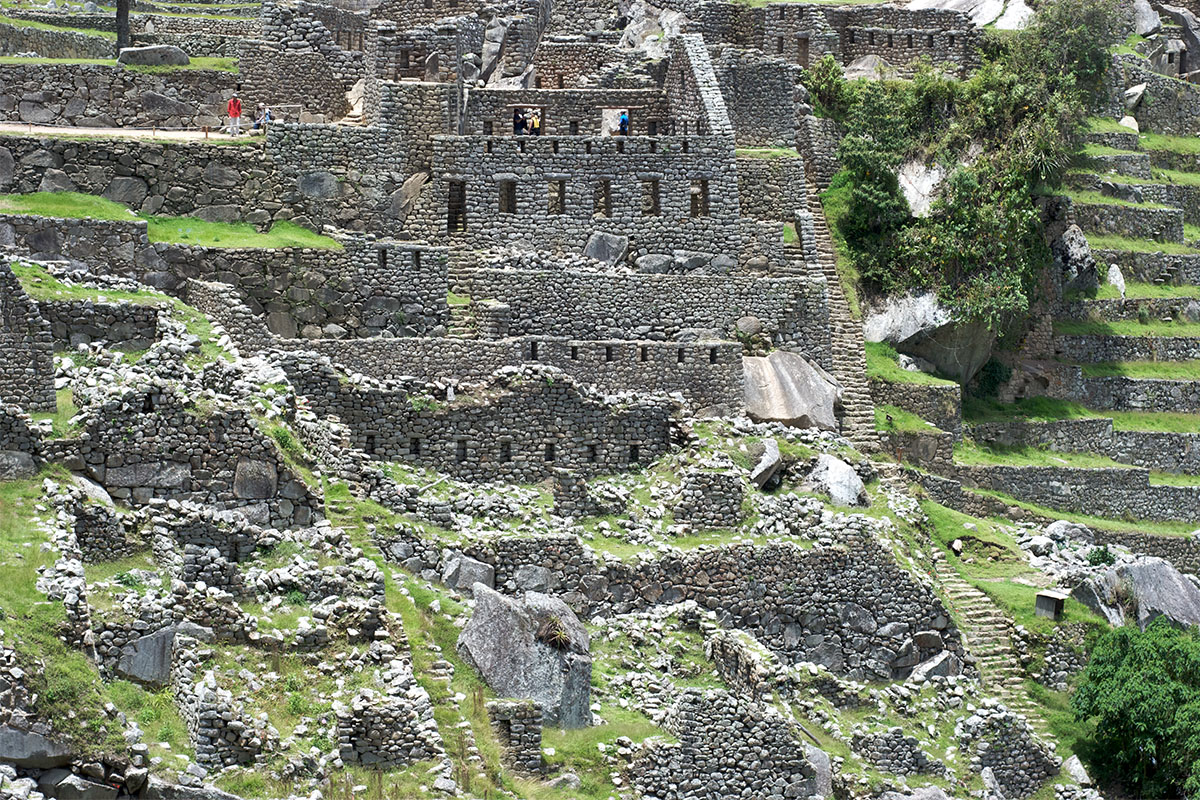
KÜHL's 5 Tips for Hiking the Inca Trail
Hiking the Inca Trail trek may be one of the most rewarding experiences in your lifetime. But its physical challenges are not to be underestimated. Here are some crucial tips for getting the most out of your Inca Trail adventure:
- Set your own pace. Don't worry about being the slowest hiker in your group. There will be a guide at the front and another at the back, so there's no risk of getting lost. Take your time to appreciate the scenery and the ruins along the trek. That's why you chose to hike the trail, anyways.
- Prepare physically. You'll be battling four days of relentless uphills and downhills. Get reasonably fit, seriously.
- Pack light but smart. Be ready for all seasons regardless of when you plan to hike Machu Picchu Inca Trail. Be sure to include a waterproof poncho, athletic wear, and thermals.
- Acclimatize properly. Give yourself enough time at Cusco to get used to the higher elevations. Get prescription medication like Diamox to help lessen the symptoms of mountain sickness. Chewing coca leaves and staying hydrated also increase your chances of surviving the Inca Trail hike.
- Prepare mentally. The Inca Trail may be of moderate difficulty level. And thousands of trekkers, including children, conquer it each year. But don’t underestimate it.
Final Thoughts
The trains from Cusco to Machu Picchu Pueblo (Aguas Calientes town) offer a super comfortable way to get to Machu Picchu. On the other hand, hiking the multi-day Inca Trail is challenging, and the risk of altitude sickness is real. But the experience of watching the dazzling city of Machu Picchu unfold in front of you after walking the ancient Inca path for days is unparalleled.
Featured image by Tom Cleary.
FAQs
Can a beginner do the Inca Trail?
In addition to being a moderate-level hike, the Inca Trail to Machu Picchu can be completed in 2, 4, or 5 days. Our advice to beginners planning to hike the full trail is to consider the 5-day hike as it’s slow-paced and it offers enough time to rest.
What is the scariest part of the Inca Trail?
Most trekkers dread the Dead Woman’s Pass because it’s the steepest part of the Inca Trail at 4215 meters.
What is the failure rate of the Inca Trail?
Over 90% of the trekkers who set off for the Inca Trail trek make it to Machu Picchu.
Who suffers most from altitude sickness?
People who live in low-altitude areas are more susceptible to mountain sickness. However, you may be at a higher risk if you have existing heart or lung conditions.
Is the Inca Trail crowded?
Since 2001, only 500 people (of which 300 are guides, porters, and cooks) are allowed on the Inca Trail daily. Thanks to this regulation, the Inca Trail is less congested than it used to be.


